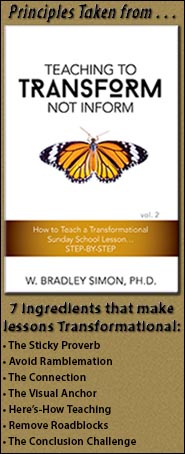Teaching a Bible Study
Topic: Teaching a Bible study is more than giving information and explanation, it's changing lives through the Word.
Teaching a Bible study Vs Ramblemation
How to avoid becoming an audible commentary when teaching a Bible study.
Have you ever been in a conversation with someone and after ten minutes you're not sure what point they are trying to make? Even after asking a few clarifying questions and listening for another ten minutes, you still have no clue if a point exists somewhere within all those words. One topic just seems to role into another, and another, and another. It's not that their words are incomprehensible. You just can't figure out what point they're trying to make or where the entire conversation is headed. After a while, you conclude there is no point and they are just telling you a bunch of stuff.
Even though we are careful not to speak this way in regular conversations, being aware of and preventing this form of communication is more difficult to do when teaching a Bible study. It has a way of sneaking into our teaching completely unnoticed. And even if it is noticed, some don't see it as a problem. After all, isn't it normal to present various topics when teaching a Bible study?
Of course, if you're familiar with using Sticky Proverbs when teaching a Bible study (see Teaching To Transform Not Inform 2), then you know that the answer to this question is, “No!” Teaching a Bible study is not the presentation of a series of related topics; rather, it is the explanation, expansion, proof, support, illustration, and application of the passage's central truth encapsulated in the Sticky Proverb.
Result of Teaching a Bible study Without a Sticky Proverb
When we don’t take the time to find and develop a Sticky Proverb, then no particular central point is explained, proved, and integrated into listeners’ lives. Teaching a Bible study without a defined core truth, often sounds like an extended audible commentary that explains verse after verse and point after point.
If you are teaching a Bible study without a specific focus, then you will give a lot of information and make numerous points, but you won’t prove any specific overarching point. Within the thirty to forty minutes of explanation, you will give little more than a cursory solution to any particular problem. You will shoot numerous informational arrows, but instead of shooting at a specific target, they are shot in the same general direction with the hope that when they come down, they will hit some target in the listeners’ lives.
Granted, when the arrows finally come down, they will hit targets here and there, but because they land all over the place, their overall impact will be minimal. No one denies you are teaching a Bible study filled with information, but it is information without a destination … arrows without a specific target.

When teaching a Bible study
The Sticky Proverb prevents
explanation without a destination,
arrows without a target.
Teaching a Bible study free of Ramblemation
To make it easier to refer to, I have given a name to this form of teaching a Bible study where the teacher wanders from verse to verse while giving explanation along the way. I call it Ramblemation.
ram•ble•ma•tion [ram-buhl-mey-shuhn]
noun
(1) rambling information.
(2) explanation without a destination.
(3) the act of wandering or meandering through the text giving various definitions, explanations, and background information unrelated to, or only partially related to, any particular central point or objective.
The best way to avoid Ramblemation when teaching a Bible study
Teaching a Bible study is not the presentation of a series of related topics; rather, it is the explanation, expansion, proof, support, illustration, and application of a single central truth, namely, the Sticky Proverb.
The best way to avoid Ramblemation when teaching a Bible study is to first create a Sticky Proverb, then develop the rest of the Bible study around this specific emphasis, angle, focus, direction, or target. The Sticky Proverb clarifies the Bible study’s main points, necessary discussions, potential roadblocks, and application. Once these elements are clear, they keep you from jumping from topic to topic to topic when teaching a Bible study.
To learn more about avoiding Ramblemation while teaching a Bible study, see chapter 3 in Teaching to Transform Not Inform 2: How to Teach a Transformational Sunday School Lesson...STEP-BY-STEP.
![]()
To find more links on teaching a Bible study, see the following:
- How to teach a Bible study
- Teaching the Bible
- Teaching a Bible study
- How to teach a Bible study fellowship lesson
- How to lead a Bible study
- Bible study lesson
- Bible study training
- How to improve communication
- Preparing yourself to teach
- by Brad Simon
Book 1 Topics for: teaching a Bible study | Book 2 Topics for: teaching a Bible study |
|---|---|
| How to unlock Bible study growth with transformational teaching | Learning how to use the seven essential elements needed when teaching a Bible study. |
| Coaching teachers to become one of the imperfect people God uses | Guiding teachers to use the Sticky Proverb. |
| Instruction that creates a ripple that continues into eternity | Training teachers to use Visual Anchors when teaching a Bible study. |
| Teaching a Bible study | Giving challenges, assignments, exercises, and homework that encourage change. |


